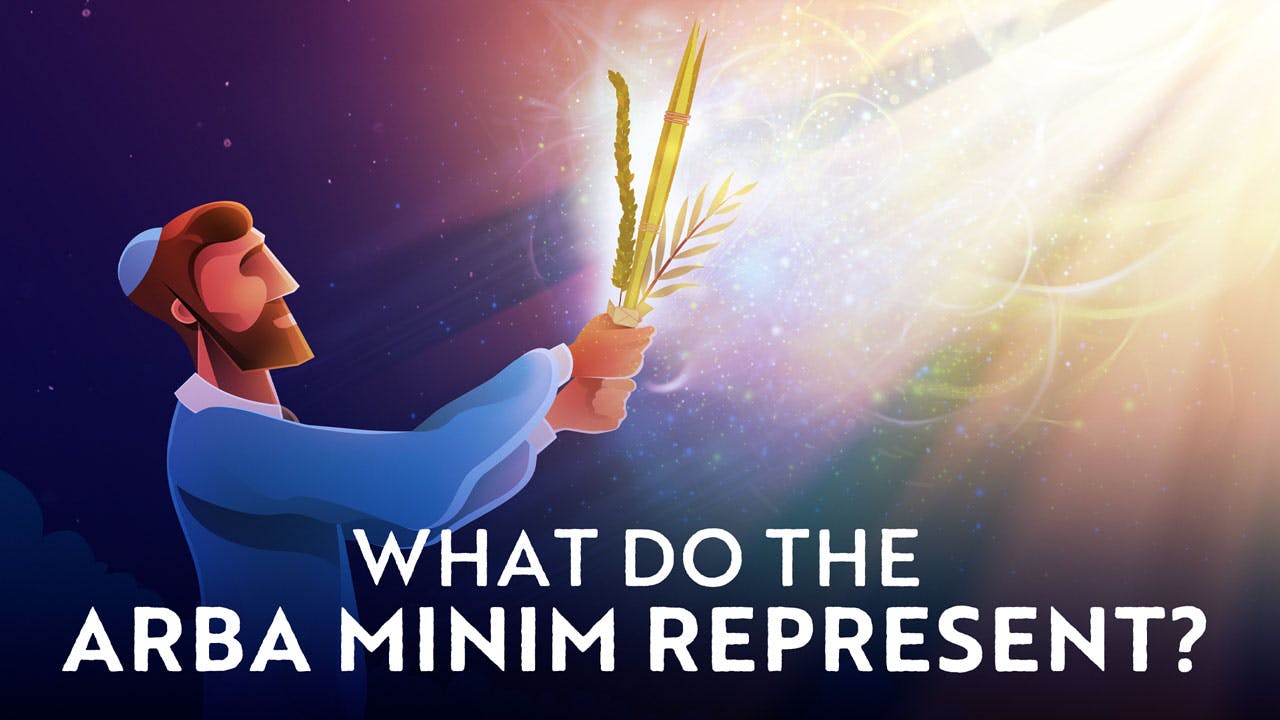
Why Do We Shake the Lulav and Etrog on Sukkot?
The Meaning of the “Four Species”
BY Sarah Rashba | February 7, 2024 | 5 Minute Read
How do these particular plants enhance our joy on Sukkot?
Why these plants?
The Torah commands us to “take” four types of plants – the arba minim – when we celebrate Sukkot. But what’s the meaning behind this mitzvah? Lots of us have heard explanations for the “four species” – for example, that they represent four parts of the body, or four kinds of people. When we look in the Torah itself, though, we don’t find any of those explanations. Here are the words of the commandment:
וּלְקַחְתֶּם לָכֶם בַּיּוֹם הָרִאשׁוֹן פְּרִי עֵץ הָדָר כַּפֹּת תְּמָרִים וַעֲנַף עֵץ־עָבֹת וְעַרְבֵי־נָחַל וּשְׂמַחְתֶּם לִפְנֵי יקוה אֱלֹקיכֶם שִׁבְעַת יָמִים׃
On the first day you shall take the product of hadar trees, branches of palm trees, boughs of leafy trees, and willows of the brook, and you shall rejoice before your God יקוה seven days.
(Leviticus 23:40)
It doesn’t look as if there’s any specific reason for using these plants at all! Instead, all we get is:
Step 1: Take these plants.
Step 2: Celebrate Sukkot for seven days.
So…that’s what we do! But wouldn’t it be more satisfying if we could figure out the connection between Step 1 and Step 2? Wouldn’t it be great if we knew how taking the lulav and etrog connect to the meaningfulness of Sukkot?
The arba minim and the joyfulness of Sukkot
If we look a bit deeper into the Torah’s description of this mitzvah, there really is an explanation. It’s an explanation that shows us what’s meaningful about the arba minim, but it does more than that. It’s also a key to the entire spiritual meaning of this holiday. But to see it, we’re going to have to take a step back and talk about the holiday itself. And once we’ve done that, we’ll have our clue to the significance of taking these four plant species on Sukkot.
To begin seeing all this, let’s take a second to think about how we describe Sukkot in the holiday prayers. It’s called zman simchatenu, “the time of our joy.” Did you ever wonder about that? After all, it sounds kind of…generic. Isn’t every holiday supposed to be a time of joy? And this title sounds especially vague compared to the way we describe other holidays.
Passover? It’s called zman herutenu, “the time of our freedom.” That fits, because we were freed from slavery in Egypt.
Shavuot? It’s zman matan Toratenu, “the time of the giving of our Torah.” Exactly! We celebrate receiving the Ten Commandments on Shavuot.
So what’s with calling Sukkot “the time of our joy”? That doesn’t seem to tell us anything about what this holiday actually celebrates! Could it be that the Sages ran out of good ideas for describing holidays and ended up just labeling Sukkot “Joyfulness Time”?
The four species and the secret of real joy
As it turns out, there’s a deeper reason for naming Sukkot “the time of our joy.” And it’s a reason that could also answer our question about why the Torah wants us to take these four species on Sukkot.
Let’s go back and read that verse again: “On the first day you shall take the product of hadar trees, branches of palm trees, boughs of leafy trees, and willows of the brook, and you shall rejoice before יקוה your God seven days.”
What if that verse isn’t just a disconnected Step 1 and Step 2 that have nothing to do with each other? What if it really means something like, “When you take these four plants…then you’ll be truly rejoicing”?
If we understand the verse that way, then what it’s telling us is this: Something about the arba minim can teach us the true meaning of rejoicing before God. And something about that joy is at the heart of what it truly means to celebrate Sukkot.
What it really means to rejoice on Sukkot
Are you curious? Join us for a close reading of the Torah text that answers all these questions and offers us a mind-blowing new explanation for the arba minim! It’s a beautifully animated video that you can watch or listen to. Transcript available as well! Subscribe to check it out now.
More Sukkot Videos

The Hidden Meaning Of Sukkot
Video • 30 min
Why do we celebrate Sukkot? Because the Israelites slept in huts in the desert after fleeing Egypt… right? Well, what if that answer is incomplete? What if the Torah offers us a deeper story about the meaning of this holiday…and it’s hiding in plain sight?

An Epic Understanding Of The Jewish Holidays
Video • 12 min
When it comes to the Jewish holidays, we tend to relate to each one on its own. But often, we miss the bigger picture. The Torah actually talks to us in epic, sweeping terms about the very idea of a “holiday,” about how to understand the holidays and find meaning in them. Come into the text and get ready to unravel the Torah's secret about the true meaning of Sukkot, Pesach, and Shavuot.
Sukkot Pages
What is Aleph Beta?
Aleph Beta is a unique kind of Torah library. Led by our founder, Rabbi David Fohrman, we are dedicated to high-level, textual Torah learning for adults that is intellectually and spiritually sophisticated, that enlivens your Jewish practice and helps you forge a deeper connection to God. Whether you’ve been learning in yeshiva for years or you’re just beginning your Torah journey, you’re sure to find something meaningful and surprising waiting for you here.
Browse our library of over 1,000 beautifully produced animated videos, podcasts, deep dive courses, and printable guides. Topics include the weekly parsha, Jewish holidays & fast days, laws & mitzvot, prayers, relationships, big philosophical ideas and more. Have something to say at the Shabbos table that will amaze your family and guests and bring deep meaning into their lives.



